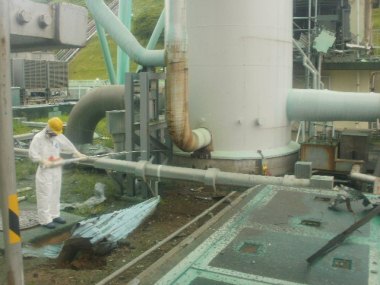An area of extremely high radiation has been found at Fukushima Daiichi in a filtration system that helped to reduce emissions from the reactor accident. New water treatment equipment is starting trial operation.
Tokyo Electric Power Company (Tepco) declared a reading in excess of 10,000 millisieverts per hour coming from part of the Standby Gas Treatment System (SGTS) for units 1 and 2. This moves air from the reactor buildings to the environment through a series of filters, ultimately releasing it through an exhaust stack shared by those reactors. It also provides the route from which excess pressure can be released by venting.
 |
| Taking measurements at the foot of the stack yesterday |
During normal operation the system also maintains low pressure within the reactor buildings to prevent any potentially contaminated air leaving through tiny holes. In addition to its use during the venting of units 1 and 2 during the accident, it may also have been in operation since power was re-connected, slowly building up radioactivity as it filtered air from the highly contaminated reactor buildings.
The high dose rate was measured in the last part of the SGTS, very near the foot of the stack, and highlighted on a radiation map of the Daiichi site released by Tepco.
Comparison to earlier versions of the map showed that Tepco has cleared many of the radiation hotspots caused by rubble spread around by explosions at the height of the accident sequence. Patches of concrete and steel previously recorded at 950, 550 and 170 millisieverts per hour have been cleared, although more work remains regarding areas with readings of 250, 160 and 120 millisieverts per hour.
In line with this work, as well as the spraying of dust control agents, air sampling at the site border yesterday showed no detection of iodine-131, caesium-134 or caesium-137. This actually shows that airborne radiation at the plant boundary is low enough for normal working practices but Tepco is not expected to lower its precautions for some time to come.
Water treatment and cooling
Tepco is constructing a new treatment system to supplement current arrangements for water that has built up in the basements of units 1, 2 and 3 having leaked through the reactor vessel. Management of this water, which once approached a total of 100,000 tonnes, has been a major concern.
An ad-hoc cooling loop sources water from the basements and treats it before re-injection to the reactor vessles, but pipework for this is extensive and problematic. It currently includes an Areva-supplied treatment system, while a second 'streamlined' system is forthcoming using equipment from Toshiba. The use of these two centres should increase "stability and redundancy," Tepco said.
Levels of water in the basements are on a gradual downward trend, which should eventually allow Tepco to step up the rate at which coolant water is injected and aim for 'cold shutdown' for all three wrecked reactor cores. Unit 1 has been below 100ºC for several days, while unit 3 is at 106.6ºC. Unit 2 however, remains further from the goal at 122.5ºC.
Researched and written
by World Nuclear News




_30199.jpg)
_72306.jpg)

_49562.jpg)





